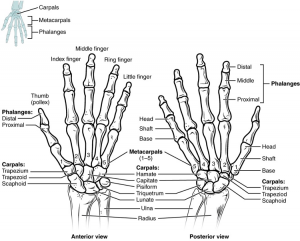The fingers and thumb contain 14 bones, each of which is called a phalanx bone (plural = phalanges), named after the ancient Greek phalanx (a rectangular block of soldiers).
The thumb (pollex) is digit number 1 and has two phalanges, a proximal phalanx, and a distal phalanx bone (Picture 1).
Digits 2 (index finger) through 5 (little finger) have three phalanges each, called the proximal, middle, and distal phalanx bones. An interphalangeal joint is one of the articulations between adjacent phalanges of the digits (Picture 2).
Common Characteristics of Phalanges
Each consists of a body and two extremities:
- The body tapers from above downward, is convex posteriorly, concave in front from above downward, flat from side to side; its sides are marked by rough which give attachment to the fibrous sheaths of the Flexor tendons.
- The proximal extremities of the bones of the first row present oval, concave articular surfaces, broader from side to side than from before backward. The proximal extremity of each of the bones of the second and third rows presents a double concavity separated by a median ridge.
- The distal extremities are smaller than the proximal, and each ends in two condyles separated by a shallow groove; the articular surface extends farther on the volar than on the dorsal surface, a condition best marked in the bones of the first row.
The ungual phalanges are convex on their dorsal and flat on their volar surfaces; they are recognized by their small size, and by a roughened, elevated surface of a horseshoe form on the vo

